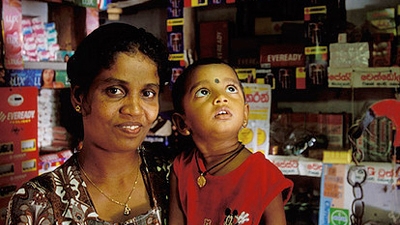What triggered this revolution?
Despite the Government’s goal of ensuring that 75% of the households in Sri Lanka have electricity by 2007, prevailing technical and financial concerns had limited conventional grid supply. Even with rapid expansion, twenty percent of the island's population would remain in the dark, reliant only on off-grid systems, even in the new millennium.
The Sri Lankan Government recognized the problem and worked with the World Bank to lay the foundation for this transformation through the Energy Services Delivery Project (ESD) in 1997. The 2002 Renewable Energy for Rural Economic Development project (RERED) took grid/off-grid electricity services to the next level reinforcing the World Bank’s commitment to green energy. Increased demand fueled additional financing from IDA that further enhanced the successful impacts and results of ESD/RERED.
The projects support the provision of electricity and socioeconomic improvements in rural areas through: (i) grid-connected and off-grid hydro, wind and biomass renewable energy technologies; (ii) financing and grant mechanisms for solar home systems and other solar energy applications in rural areas through private companies, non-governmental organizations and micro-finance institutions; (iii) technical assistance for income generation and social service delivery improvements based on villages’ access to electricity; and (iv) technical assistance to promote energy efficiency, development of carbon trading mechanisms and integration of renewables into government policy, provincial council development strategies and sector reform initiatives.
The innovative approach of financing these investments tapped into latent entrepreneurial talent of the Sri Lankans to develop new business models for the provision of a variety of energy services. The Administrative Unit (AU), contracted-out by government to implement the credit program, created and maintained an enabling environment of capacity building, technical assistance and financial products for each renewable energy industry category and was instrumental in the success of the program. It served as a platform for the various stakeholders to come together and aided the mobilization of industry associations, professional services accreditation and quality assurance standards. Furthermore, by training local youth in various aspects of the renewable energy industry the project created a skilled workforce that could be readily tapped by the various companies and entrepreneurs.
Entrepreneurs were able to leverage the standard small hydro power purchase agreement framework and the bulk power tariff determination to develop bankable grid-connected hydropower plants and sell power produced directly to the Ceylon Electricity Board, the country’s largest utility. Today, over 167 megawatts is being supplied to the grid from these renewable energy projects which include the first privately-owned 10 megawatt wind farm in Sri Lanka. This marks more than a five-fold increase in less than a decade – a number that continues to grow. According to the latest Monitoring and Evaluation reports, the estimated employment value generated, just in the construction of 70 grid-connected hydro sub-projects, is about Rupees 300 million (~US$3 million). In addition each grid-connected hydro sub-project employs 8-11 persons from the community during the construction period creating an average income of Rupees 1.3 million (or about US$ 12,000) per community. After each plant is commissioned, 3-4 persons are employed for operations and maintenance.
Beyond the grid, community investments have taken place in over 150 villages throughout Sri Lanka to build mainly hydro schemes and a few small biomass investments. The combined output of these village schemes has reached roughly 1,526 kilowatts which is providing electricity to 5,659 households. With many investments still under implementation, the number of beneficiaries is constantly increasing. Furthermore, over 138,000 SHS have been installed with enough capacity to power television sets, light bulbs and mobile phone chargers for every household.
“Now we have electricity in our village. Therefore, we are happy. Earlier, we used to get up late in the morning and felt lazy to cook breakfast with a kerosene lamp. Often our children used to eat unhealthy food from the village tea boutique on their way to school. But, now we get up early in the morning and cook breakfast at home. Our children get a healthy meal before they go to school. We also save money. I would say, electricity has lit our lives," said a mother and the Treasurer of Village Electricity Consumers’ Society.
With over 1,300 kilometers of coastline and the regional wind resource measurements currently being studied, the development of future wind parks in Sri Lanka is promising. The recent revision of the tariff structure provides the much needed “wind in the sails” for private sector led investment in the wind power industry and carbon trading mechanisms offered on the international market will also be tapped to improve financial returns.
What Next?
An important and far reaching benefit gained from this is the strengthening of critical capacities among stakeholders to harness nascent renewable energy technologies and business models down to the village Electricity Co-operative Societies. But more importantly, the near 100 percent indigenization of equipment, services and financing, showcases the innate entrepreneurship of Sri Lankans and is now the hallmark of this industry. The projects have promoted private sector and community led implementation as well as touched on several key socioeconomic aspects critical to economic development such as productive use and reliance on indigenous energy resources and improvement of social delivery services in rural areas through community mobilization and asset creation. Entrepreneurs who started in this industry are now well established enough to undertake similar projects in African countries, creating an export potential for Sri Lanka! Furthermore, the Sri Lankan Government’s support through favorable policies and the establishment of institutions will further enhance the strong foundation of technical and social capital in the renewable energy sector. This will enable them to capture and sustain the gains made and continue to develop the renewable energy sector and benefit rural people, the national economy and the environment going forward.

